
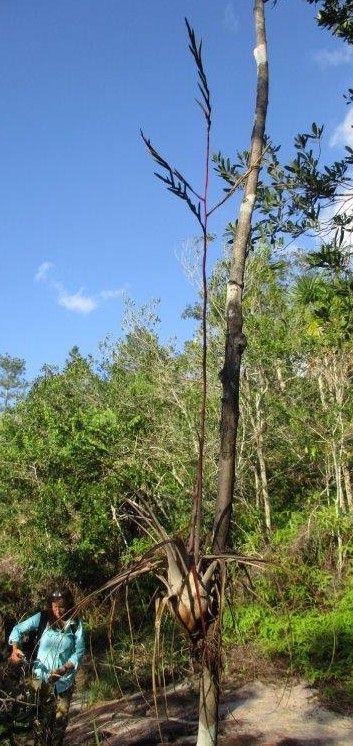
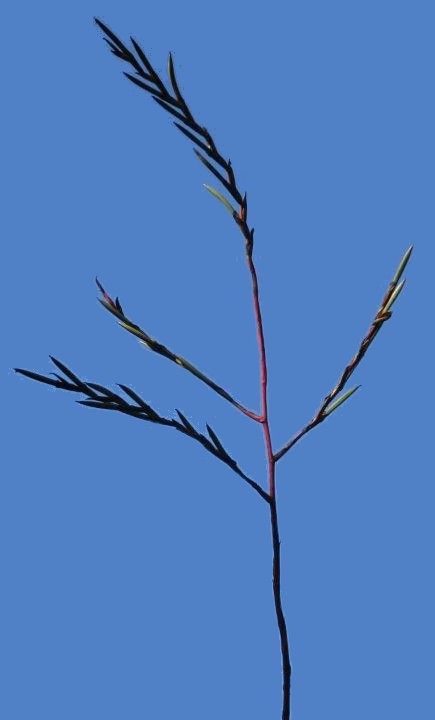
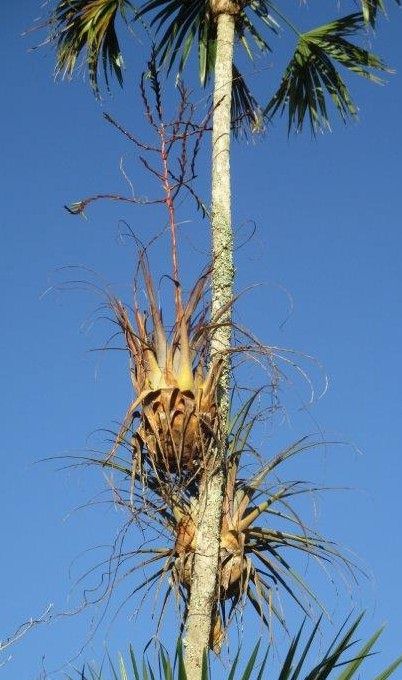
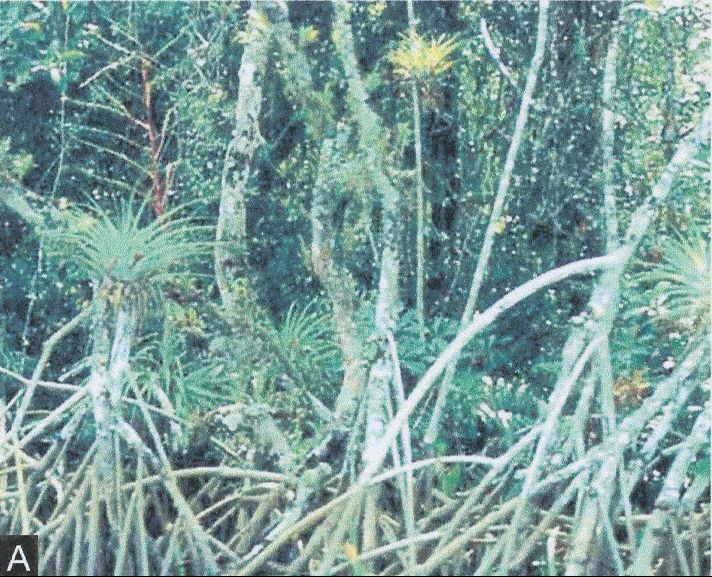
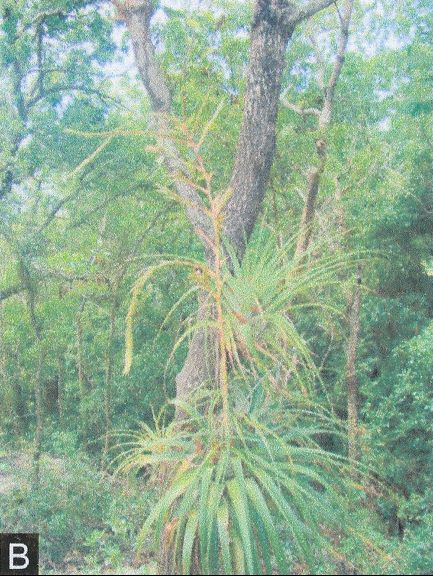
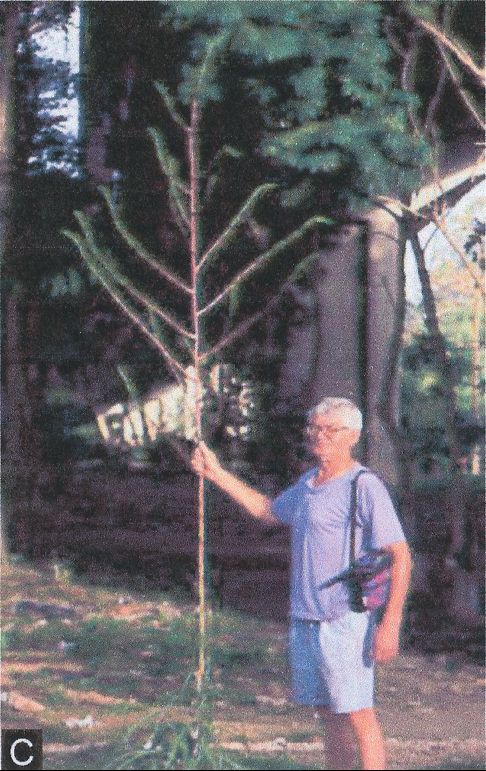




Tillandsia izabalensis Pinzon, I.Ramirez & Carnevali, spec. nov. Phytotaxa 61: 11-14, Fig. 4. 2012
A species similar to Tillandsia cucaensis, from which it differs by its open rosette with flexible leaves, white or whitish green petals, lighter than the sepals, and veined floral bracts in dried specimens. It is also similar to T. dasyliriifolia and T. limbata, differing from the former by having an open rosette with flexible leaves, and from the latter by lacking the vinaceous tinges in the inflorescence and floral bracts; it also differs from both species by being monocarpic and having longer floral bracts and calyces.
Type:-HONDURAS. Islas de la Bahia: Cayos Cochinos, Cochino Pequeno, estacion cientifica, island group NE of La Ceiba, S of Isla Roatan, -20 km N of mainland, 1-145 m, 8 May 1995, Foster 15523 (holotype TEFH!) (Fig. 5).
Herb, epiphyte, 70-300 cm tall when flowering, apparently monocarpic. Rosette open, acaulescent.
Leaves recurved, 22.0-85.8 cm long;
sheaths elliptic, 45-165 x 28-75 mm, abaxially whitish-green to castaneous, smooth, densely lepidote, adaxially light castaneous to dark brown, with or without violaceous tinges, smooth to slightly veined upon drying, densely to sparsely lepidote, scales appressed, with inconspicuous wings;
blades narrowly triangular, 2.9-5.4 times longer than the foliar sheath, 19-63 mm wide at the junction with the sheaths, flexible to subcoriaceous, apex attenuate, not pungent, abaxially whitish-green, slightly veined, densely lepidote throughout, with cinereous, spreading scales, homogeneously distributed, adaxially green, smooth, finely veined in dried specimens, densely lepidote in the basal third, sparsely lepidote or glabrous in the central and apical thirds, with subcinereous or hyaline, spreading or appressed scales;
foliar scales with verrucose wing cells, margins entire.
Peduncle erect, 3.9-11.3 mm diameter at the apex, dull pink to red, smooth, glabrous, rigid;
basal bracts of the peduncle foliose, abaxially whitish-green, smooth to finely veined upon drying, densely lepidote on both sides, imbricate, blade arching to pendant, apex subulate;
apical bracts of the peduncle ovate-lanceolate, abaxially green with pinkish or reddish tinges, smooth or finely veined upon drying, glabrous or sparsely lepidote, not pungent, adaxially lepidote, base partially or totally amplexicaul, apex acuminate to acute, remote.
Inflorescence a panicle, once divided; axis straight, 3.0-6.3 mm diameter in the middle, green to bright pink, smooth, glabrous, internodes 26.6-64.0 mm long;
primary bracts ovate-lanceolate, 25.9-55.0 mm, abaxially green with or without pink-red tinges or totally red, smooth, glabrous, adaxially lepidote, apex acuminate to acute;
branches ascendant, straight 12.0-65.5 cm, with a basal sterile zone of 24.0-179.3 mm, the longest in the basal branches, the shortest in the apical ones;
rachis flexuous, flat next to the flowers, 1.2-3.4 mm diameter in the middle, green to bright pink, glabrous, internodes 11.4-31.0 mm long;
floral bracts ovate-lanceolate to ovate, 19.0-40.0 mm long, 5.9-11.8 mm in half width, on average longer than the rachis internodes, abaxially green or yellowish-green, with or without pinkish or reddish tinges, smooth, glabrous, adaxially densely lepidote, base totally amplexicaul, not keeled, coriaceous, apex acute to obtuse, margins hyaline.
Flowers distichous, 72 mm long, appressed to the rachis, sessile;
sepals obovate, 20.9-39.0 mm x 10 mm, abaxially green, smooth, glabrous, adaxially lepidote, not keeled, coriaceous, apex rounded, margins hyaline;
corolla tubular, actinomorphic or slightly zygomorphic, constricted at the height of the ovary's apex, erect or slightly curved at the apex of the sepals;
petals 40.0 -41.8 mm long, white, whitish green or cream colored, apex rounded and erect, margins hyaline;
stamens exserted in two series of unequal length;
filaments 52.6-57.0 mm long, with the same width in all of their longitude, rounded in cross section, pale green;
anthers oblong, subbasifixed, versatile, black or brown; style exserted, 63.1 mm long, longer than the stamens, pallid green;
stigma green, lobes conduplicate, spread, not spiraled, papilose.
Capsules cylindrical, 45.0-70.6 mm long, externally castaneous, internally black, shiny, smooth, apex mucronate.
Seeds fusiform, brown, with two plumose appendages, the apical one shorter than the body of the seed, the basal one long and comose.
Other specimens examined (paratypes):-BELIZE. El Cayo: Augustine, Mountain Pine Ridge, 457 m, 26 March 1960, Hunt 612(US).Toledo: Punta Gorda, W of beach rd., 23March 1967, E. Dwyer & M. Dwyer 623 (MO). COLOMBIA. San Andres y Providencia: Isla de Providencia, 13°2l'N, 81°23'W, 29 March-9 May 1948, Proctor 3480 (PH).CUBA. Without precise locality: 1968, Schubert s.n. (HAL). GUATEMALA. Baja Verapaz; Purulha, 12 June 1980, Luther s.n. (SEL). El Progreso: El Rancho, 500 m, March 1993, Salazar s.n. (MEXU). Izabal: Rio Dulce, 1992, K. & R. Ehlers EG922001 (WU); vicinity of Quirigua, 75-223 m, l5-30 May 1922, Standley 24228 (US); between Milla 49.5 and ridge 6 miles from lzabal, Montana del Mico, 65-600 m, 1 April 1940, Steyermark 38542 (F); Livingston, 150 m, 2 August 1998, Veliz s.n. (MEXU). Without precise locality: Eastern portions of Vera Paz and Chiquimula, 1885, Watson 49 (US). HONDURAS. Gracias a Dios: Arroyada del rio Dursuna; 70 km al O de Puerto Lempira, 15°00'N, 85°13'W, 7 April 1972, Nelson 816 (TEFH); Puerto Lempira, orilla laguna de Catarasca, l5°l5'32"N, 83°46'04"W, 6 m, 5 September 1978, Nelson 4824 (TEFH). Islas de la Bahia: Camino entre New Port Royal y Alligator Nose Beach, 0-95 m, 14 September 1982, Nelson 8441 (SEL, US); origin. coll. Cayos Cochinos, Perqueno {Pequeno}, 0-3 m, 16 JuIy 2007, Luther s.n. ex Foster s.n. (WU). Olancho: Near Rio Pueblo Viejo, between Dulci Nombre de Culmi and La Colonia, 7 February 1982, Blackmore & Heath 1738 (MO). NICARAGUA. Zelaya: in and around the Miskito Indian village of Karata on the southeastern shore of Laguna de Karata on sandy soil associated with coastal mangrove and inland pine forest and savanna, south of Puerto Cabezas, l3°55'30"N, 28°29'00"W, 0-5 m, 15-18 March 1994, Grant et al. 94-02319 (SEL).
Etymology:-The specific epithet makes reference to the Department of Izabal, in Guatemala, where this plant is abundant, according to information in herbarium specimen labels.
Phenology:-Most flowering specimens of the species have been collected between January and May, with odd flowering specimens in July. Fruiting specimens have been collected in August and September.
Variation:-The total height of Tillandsia izabalensis ranges between 70-300 cm when flowering, in a similar way as in T. dasyliriifolia. According to the information from the herbarium specimens and photographs, the coloration of the inflorescence (axis, rachis) can be green or dull to bright pink; the floral bracts are usually green but may be suffused with bright pink; the petals are white to pale green, always lighter than the sepals, which are apple green.
Ecology and distribution:-This species is distributed along the Caribbean coast, from southern Belize to northern Nicaragua, including the Islas de la Bahia in Honduras and Isla de Providencia (Colombia) (Fig. 2). It is reported in Cuba by a single specimen, which, however, lacks a precise locality. Most of the specimens examined are located within the Eastern Central America biogeographical province (Morrone 2001). The plants of this species are epiphytes, growing in tropical rain forests, mangroves, or tropical pine forests, at elevations between 3 and 550 m, in a tropical wet climate.
IUCN conservation assessment:-Least concern (LC). The distributional area of Tillandsia izabalensis (extent of occurrence) far exceeds 20000 km˛ ( >104000 k˛) and the area of occupancy spreads through most of this area. The species occurs in a variety of ecosystems at low elevations (see above). It is fairly common in many places; there is evidence that Tillandsia izabalensis forms large populations in mangrove associations and in tropical pine stands. It is also not subject to significant collecting pressures.
Tillandsia izabalensis Pinzon, I. Ramirez & Carnevali, ined. (Figura 29) Detail from Juan Pinzon’s thesis 2012
Etymology: In reference to the Department of lzabal, in Guatemala, where the largest number of collections of this species occurs.
Plant epiphyte, 70 to 300 cm high in bloom. Rosette open, acaulis.
Leaves recurved, 22.0-85.8 cm long;
Sheaths elliptical, 45-165 x 28-75 mm, abaxially pale green to chestnut brown, smooth, densely lepidote, adaxially light chestnut brown to brown, with or without violet tints, smooth, lightly veined, densely to dispersed lepidote, adpressed scales, inconspicuous wings;
Blades narrow triangular, 2.9 to 5.4 times longer than the sheath, 19-63 mm wide at base, abaxially whitish green, lightly veined, densely lepidote, scales cinereous, evenly distributed, wings of scales spreading, adaxially green, smooth or finely veined when dry, densely lepidote towards the base, sparsely lepidote or glabrous toward the middle and top, scales with extended wings, subcinereous or hyaline, papery or subcoriaceous, flexible, tip subulate, not pungent;
Leaf scales verrucose and winged, margins entire.
Peduncle erect, 3.9-11.3 mm wide at the top, pink or red;
Peduncle bracts basal ones leafy, abaxially finely veined, greenish white, densely lepidote, imbricated, blades arched or pendulous, tip subulate, upper ones ovate-lanceolate, abaxially green tinted pink or red, smooth or finely veined when dry, glabrous or sparsely lepidote, adaxially lepidote, base partially or totally amplexicaule, tip acuminate or acute, remote.
Inflorescence paniculate, divided once;
axis erect, 3.0-6.3 mm wide, pink or red, smooth, glabrous, internodes 26.6-64.0 mm long;
Primary bracts ovate-lanceolate, 25.9-55.0 mm long, abaxially green with pink or red tints or totally red, smooth, glabrous, adaxially lepidote, tip acuminate to acute;
Branches ascending, erect, 12.0-65.5 cm long, with a basal sterile area of 24.0-179.3 mm;
rachis flexuous, with a flat area adjacent to the flowers, 1.2-3.4 mm wide in the middle part, pink or red, glabrous, internodes 11.4-31.0 mm long;
Floral bracts ovate-lanceolate or ovate, 19.0-40.0 mm long by 5.9-11.8 mm wide when folded in half lengthwise, on average longer than the internodes of the rachis, abaxially green or yellowish green, with or without red tints, smooth, glabrous, adaxially densely lepidote, totally amplexicaule at base, tip acute or obtuse, margins hyaline, not carinate, leathery.
Flowers distichous, 72 mm long, adpressed to the rachis, sessile;
Sepals spatulate, 20.9-39.0 mm x 10 mm, abaxially green, glabrous, smooth, adaxially lepidote, tip rounded, margins hyaline, not carinate, coriaceous;
Corolla tubular, actinomorphic or slightly zygomorphic, constricted at the top of the ovary, erect or slightly geniculate at the top of the sepals;
petals 40.0-41.8 mm long, white, cream or whitish green, tip rounded, erect, margins hyaline; Stamens exserted, in two sets of different lengths;
filaments 57.0 mm long, of equal width in its entire length, transversally round, pale green;
Anthers oblong, subbasifixed, black or coffee coloured;
style exserted, 63.1 mm long, longer than the stamens, pale green;
Stigma green, lobes conduplicate, extended, not spiralled, papillose.
Capsules cylindrical, 45.0-70.6 mm long, externally chestnut brown, internally shiny black, smooth, mucronate tip.
Seeds fusiform, coffee colour, with two feathery appendages, the apical one shorter than the body of the seed and the basal one long comose.
Phenology: According to the viewed specimens, flowering occurs between January and May, although also reported a specimen in bloom during July. The fruiting occurs in August and September.
Nomenclatural notes: this species is new; publication is in process. Populations of this species were recognized with the name of Tillandsia cucaensis by Ehlers (2006b), although it has already been explained that this name is not for those populations (see nomenclatural notes under T. cucaensis).
Relationships and character Diagnostics:
As already explained in the section of Tillandsia dasyliriifolia, T. izabalensis is part of a clade, together with T. limbata, of species with white or greenish white flowers that are distributed on the East coast of Mexico and Central America, up to Nicaragua. T. dasyliriifolia is distinguished by its rosette open with recurved and flexible, not a funnel rosette and leathery leaves; T. limbata is distinguished by its inflorescence with straight, ascending branches, not candelabriform, with the floral bracts green with pink or red tints, not dark violet tints. Besides, T. izabalensis has flowers larger than the other two species.
Variation: Tillandsia izabalensis can have plants in bloom from 70 cm up to approximately 3 m in height, in a manner similar to T. dasyliriifolia. According to the information on the labels of herbarium specimens and photographs, the colouration of the inflorescence shaft (rachis) can range from pink to red; for its part, the floral bracts are usually green, but can have red or rose tones; the petals are reported from white to green, while from the observed photographs, they are a pale green, lighter than the colour of the sepals, and not so much an apple green, as in the petals of T. cucaensis and T. huamelulaensis, which are concolorous with the sepals.
Ecology and distribution: Distributed from South Belize to the North of Nicaragua on the Caribbean side, including the islands of the Bay in Honduras and Providencia Island, which belongs to Colombia (Figure 30). Also reported is a collection in Cuba, although no precise locality. Specimens are mainly located in the northern half of the Biogeographical province to the East of America Central and marginally in the limit Southeast of the Biogeographical province of the Gulf of Mexico (classification according to Morrone, 2001). Plants of this species are epiphytes and reportedly are growing within the rainforest, mangroves or tropical pine forests, at altitudes ranging from 3 to 550 m above sea level, in a warm humid climate.